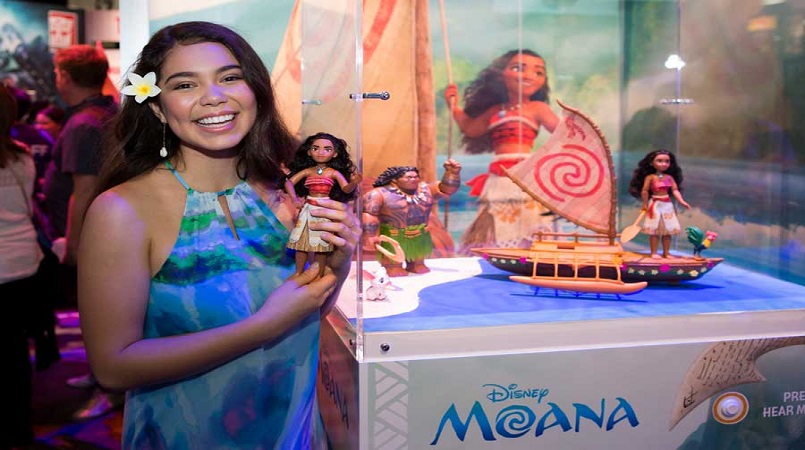
The Movie Box Office report has compiled the industry’s first full week ticket sales since the Moana & Maui theme animated movie was released – a whopping $101.6 million worldwide, the No.1 most popular movie.
The production cost was $75 million. Introducing rookie Hawaiian teenager Auli‘i Cravalho, 15, and famous actor Dwayne Johnson, of Samoan heritage. One movie critic calls it: “Proof you don’t need white heroes to star in a hit movie.”
While still in the U.S., I went out with my son’s family to see the opening show of Moana. The grand kids were all excited, they’ve been waiting to see the initial introduction of the first Polynesian theme animated movie for children.
Strategically, released during the American and Canadian Thanksgiving week, and school children are off from school.
Not a Hawaiian Story, But of Ancient Polynesia
The story is a generic Polynesian-based fictional adventure of Moana, a chief’s daughter who left her island of Motu Fiti to track down Maui. Her grandmother told Moana that Maui had taken her people’s power to voyage the vast ocean, and Moana wanted to meet Maui, and return her island’s pride and will to live.
“The adventure is based around Tonga, Samoa, and the Fiji region in ancient Polynesian,” Ms. ‘Auli‘i Cravalho (Hawaiian for beauty, gentle, bright, and other features) explained to reporters. She's part Hawaiian, Chinese, Portugee, and Irish.
Hawaii is not even mentioned, except Maui’s name, and the ancient Polynesian homeland called “Hawaiki”. Anthropologists including the late Maori Dr. Te Rangi Hiroa (Sir Peter Buck: Director of Bishop’s Museum, Hawaii) have concluded it was the ancient name for the Tahitian Western Island Group of Raiatea.
Hawaiki was the ancient center of Polynesian religion, and voyaging.
The movie is correct to refer to Hawaiki as a Polynesian Homeland, and the training academy for such political and religious reformers by the title of Lo'au: known in ancient Tonga, Samoa, and Hawaiian history.
Maui is known throughout Polynesia as a demigod of the winds and the seas. Moana (Deep Ocean) is also another generic Polynesian name common in all of Polynesian. The movie story stays true to the Polynesia myth-making traditions of people seeking help from the gods when society faces problems of catastrophic proportions.
The movie animation technology is fabulously done to impress my grandchildren. My 9-year-old granddaughter loved the Maui character. He was huge, but he was gentle and un-threatening. Maui the “trickster” was very impressive with the elements of nature, except when meeting the Queen of the Under-world.
The First of All Kind, Including a Polynesian Princess
It was also the first musical movie for tough-guy Wayne Johnson, nicknamed “The Rock”. Singing “You’re Welcome,” The Rock impressed music composer Lin-Manuel Miranda who is also the creator of the Broadway hit musical “Hamilton”.
As for teenager Ms. ‘Auli‘i Cravalho, whose voice stars as Moana, her debut role in the first Disney film made about Polynesia was a first time “mana” in the Polynesian way.
Raised by a single mother, ‘Auli‘i’s mana cast a spell and impressed a talent agent who saw her performed at a talent show months before the Moana auditioning began.
The talent agent was impressed with ‘Auli‘i that after the auditioning process, and nobody had claimed the lead role. The talent agent contacted ‘Auli‘i’s mother to fly her daughter to Los Angeles, and the rest is history. She nailed the part on her first take a year ago at 14 years old.
Lesson for youngsters with entertainment aspirations: “Don’t give up. Keep practicing your talent for the day your luck knocks on your door," says Ms. Auli‘i.
Moana First Week Ticket Sales: #1 Top Sales.
|
Worldwide: |
$101,589,690 |
|
U.S. Domestic: |
$84,411,896 |
(Sione A. Mokofisi is a syndicated journalist living in Tonga, but travels to his adopted country the USA visiting families, and completing graduate school work. He’s editor of Niuvakai-Tonga (The Tongan Inquirer) newspaper and Website. However, his opinions do not necessarily reflect the editorial policy of this Website.)
